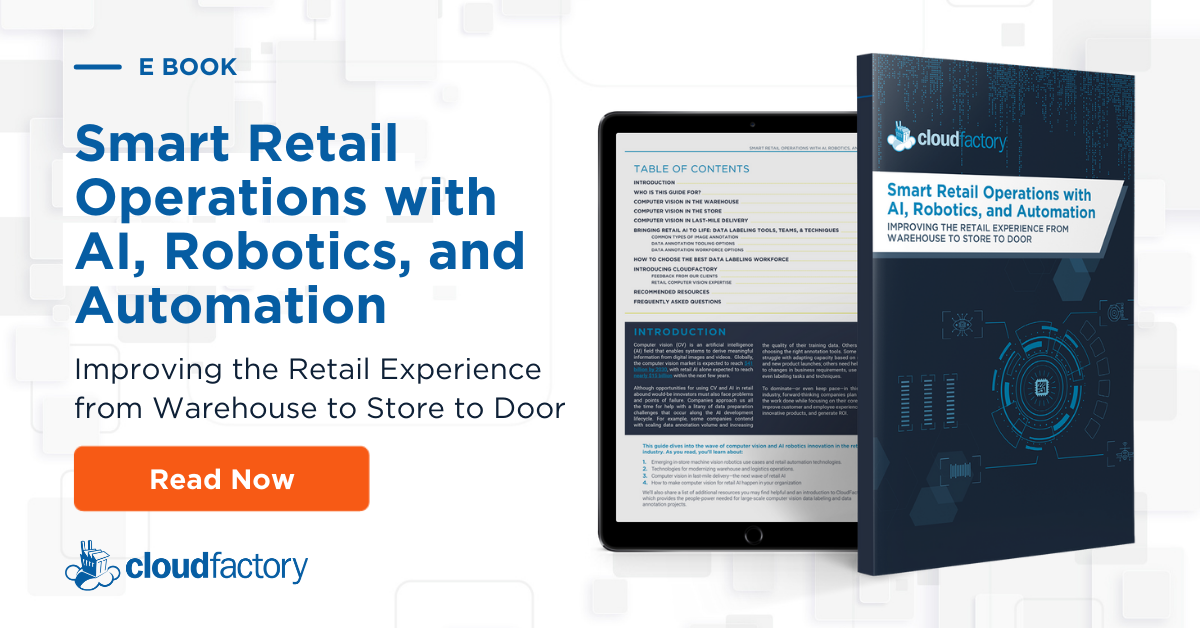This post is the second in a two-part series that focuses on how retailers are shifting to the use of warehouse robots to combat increasing demand and staff shortages. The first post, Bringing Robotic Picking and Sorting Arms to Life in Retail Warehouses, discusses how robots can streamline retail warehouse throughputs when their computer vision models run on carefully annotated image and video data.
Have you ordered from Amazon in the past few years?
Of course, you have. And chances are your order was packed, sealed, or loaded into a truck by a robot.
There are several reasons why many online consumers go straight to Amazon to order their products. Chief among them is the fact that the world’s number-one trailblazer in online retail has set the bar extremely high. As one of the primary drivers of the on-demand economy, Amazon fulfills almost two-million orders globally every day and with a very low rate of error.
To achieve this, Amazon uses over 200,000 robots to pick and pack items and load them onto palettes and trucks. This comes in addition to the nearly one-million workers it employs in the US alone, making it the country’s second-largest private employer. A constant influx of online orders, which has risen even further in the wake of the pandemic, demands such a scale and operational efficiency.
By setting the standards for online retail at a time when consumers expect instant gratification, Amazon’s innovative approach to bringing its warehouse operations to a massive scale has also had a trickle-down effect on smaller online retailers and competitors. To keep up, they too must accelerate fulfillment or risk disappointing their customers.
But, how do you keep up with this innovation?
Warehouse robotics is the answer
Traditionally, human workers handle the bulk of order fulfillment tasks in retail warehouses. Unfortunately, however, growing retail demands mean that there simply aren’t enough workers available. For larger retailers that hope to compete with the likes of Amazon, this has become an existential threat.
Almost three-quarters of retail warehouse operators in the US cannot find enough workers to keep up with demand. Those who do end up working on the warehouse floor often spend many hours on their feet performing tedious and repetitive tasks, which in turn increases the risk of fulfillment errors, burnout, and injury. Because of this, turnover is extremely high for many retail warehouse roles.
Packing robots to the rescue.
Packing robots provide immense relief for humans in operations and on the warehouse floor. With proper training, they can take on everything from packing individual shipments to loading trucks full of inventory.
Packing robots can:
- Prevent injuries from handling heavy or dangerous items
- Reduce the need for forklift and pallet jack operators by loading and unloading heavy palettes and merchandise
- Optimize space in boxes, palettes, and freight containers by loading items with Tetris-like precision
- Work longer hours and pack more items per hour than humans. Amazon’s new robots, for example, can pack 700 boxes per hour!
Packing robots help accelerate retail warehouse operations and scale fulfillment, but producing them is no easy task.
Bringing packing robots to life with high-quality training data
While robotics are fast becoming essential in larger fulfillment centers, training them can be a lengthy and challenging process. There is no such thing as an off-the-shelf solution that can be put straight into an operational environment because every industry and business has unique needs, warehouse layouts, and product lines.
Training packing robots begins with fueling artificial intelligence and computer vision models with high-quality training data. Then, these models need regular refreshing as your inventory and business needs change.
What kind of training data do packing robots need?
- Product identification: This requires precisely annotated 2-D and 3-D image and video data for each SKU, including seasonal items. Annotations must be extremely precise in cases where items are non-uniform or have reflective or translucent surfaces. robots must correctly identify every single item in a retailer’s inventory from every angle – even the damaged ones.
- Grip precision: Handling inventory in various shapes and sizes adds an extra layer of complexity to the product-specific training data. For example, a robot needs to handle a 3x3 inch box containing fragile glassware much more carefully than a 3x3 inch box of cotton swabs.
- Spatial awareness: Whether robots are picking the smallest possible box for a customer's shipment, adding packing peanuts, or loading massive palettes into trucks, they have to understand the area around them. Depending on the use case, such spatial data can be quite complex to annotate and calibrate with surrounding equipment.
Data scientists certainly have their work cut out when it comes to getting robotics algorithms ready for a production environment and keeping them in tip-top shape. Luckily, they don’t have to do all the annotation work alone.
CloudFactory is an experienced, well-trained data labeling workforce. We'll help you tackle mountains of training data, and then flexibly scale for seasonal and ongoing annotation needs. Retail fulfillment is only going to get more demanding, so finding a great data annotation partner is a huge competitive advantage for all your innovation needs.
Our managed workforce serves as an extension of your team by tackling image and video annotation and retail data processing at scale so you can focus on building the next generation of solutions for your customers. Read our retail AI guide to learn more about how smart retail technology is transforming the experience from warehouse to store to door.
Computer Vision Image Annotation AI & Machine Learning Retail Data Annotation



